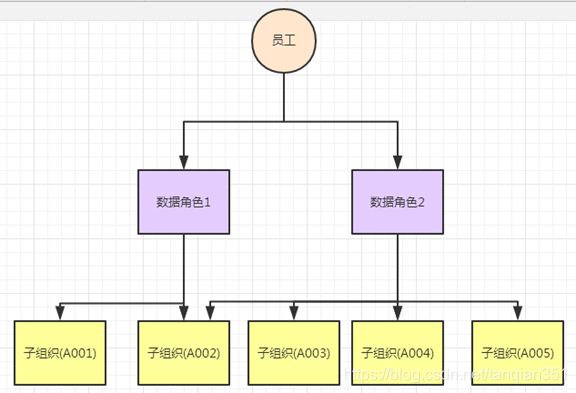基于mybatis拦截器实现数据权限
数据权限是很多系统常见的功能,实现的方式也是很多的,最近在做项目的时候,自己基于mybatis拦截器做了一个数据权限的功能。
**功能设计
a) 需要做数据权限功能的表加上一个权限id字段。
权限id可以不仅仅是组织,还可以是其他自定义的字段,用来做数据权限,如:
| 主键Id |
字段1 |
字段2 |
字段3 |
权限id |
| 1 |
xxx |
xxx |
xxx |
A001 |
| 2 |
xxx |
xxx |
xxx |
A002 |
| 3 |
xx |
xxx |
xxx |
A003 |
b) 1.分配权限id给数据角色;2.分配角色给员工, 这样就实现了权限的分配。
c) 员工-岗位-组织的关系如下,可以加一个开关,可以选择是否同时选用默认组织的权限数据。
d) 取到步骤b)和c)的权限id列表后,组装到sql里面进行如下查询:
select * from table where 权限id in (‘A001’,’A002’,’A003’)
e) 为了减少代码的耦合性,采取注解的方式,在mapper.java的查询方法上面加注解:
**前台页面参考
测试表:
CREATE TABLE `lcp_test_auth` (
`test_auth_id` bigint(20) NOT NULL COMMENT '主键ID',
`attr1` varchar(64) NOT NULL COMMENT '字段1',
`org_id` bigint(20) NOT NULL COMMENT '组织id',
`warehouse_id` bigint(20) NOT NULL COMMENT '仓库id',
`created_by` bigint(20) DEFAULT NULL,
`creation_date` datetime DEFAULT CURRENT_TIMESTAMP,
`last_updated_by` bigint(20) DEFAULT NULL,
`last_update_date` datetime DEFAULT CURRENT_TIMESTAMP,
`object_version_number` bigint(20) DEFAULT '1',
`request_id` bigint(20) DEFAULT NULL,
`program_id` bigint(20) DEFAULT NULL,
`last_update_login` bigint(20) DEFAULT NULL,
PRIMARY KEY (`test_auth_id`)
) ENGINE=InnoDB DEFAULT CHARSET=utf8 COMMENT='数据权限测试表';
**后台功能实现
a) mybatis拦截器的xml配置,先在xml中配置好plugins,也就是自定义拦截器的类
b) 编写自己的拦截器类,我在拦截器里面需要做的事情是:
1.得到将要执行的原来的sql;
2.从request里面得到当前登录的用户的信息;
3.根据当前用户信息查询其拥有的权限数据;
4.根据权限数据拼接sql并修改原sql;
5.sql执行,完。
关于mybatis拦截器的内容可以参考:https://blog.csdn.net/xiao_jun_0820/article/details/70308253
下面是我的mybatis拦截类,其中DataAuth 是我的注解类,AuthSqlSource是我的sqlSource类,仅作为参考(直接copy肯定是跑不起来的,嘿嘿)
package com.fsl.lcp.interceptor;
import org.apache.ibatis.executor.Executor;
import org.apache.ibatis.mapping.BoundSql;
import org.apache.ibatis.mapping.MappedStatement;
import org.apache.ibatis.mapping.SqlSource;
import org.apache.ibatis.plugin.*;
import org.apache.ibatis.reflection.DefaultReflectorFactory;
import org.apache.ibatis.reflection.MetaObject;
import org.apache.ibatis.reflection.factory.DefaultObjectFactory;
import org.apache.ibatis.reflection.wrapper.DefaultObjectWrapperFactory;
import org.apache.ibatis.session.ResultHandler;
import org.apache.ibatis.session.RowBounds;
import org.slf4j.Logger;
import org.slf4j.LoggerFactory;
import org.springframework.context.ApplicationContext;
import org.springframework.web.context.request.RequestAttributes;
import org.springframework.web.context.request.RequestContextHolder;
import org.springframework.web.context.request.ServletRequestAttributes;
import com.fsl.lcp.annotation.DataAuth;
import com.fsl.lcp.auth.dto.AuthorityResource;
import com.fsl.lcp.auth.service.IAuthorityResourceService;
import com.fsl.lcp.auth.service.IDataRoleResourceService;
import com.fsl.lcp.auth.sqlsource.AuthSqlSource;
import com.hand.hap.core.components.ApplicationContextHelper;
import java.lang.reflect.Method;
import java.util.List;
import java.util.Properties;
import javax.servlet.http.HttpServletRequest;
/**
* mybatis数据权限拦截器
* @author tanqian
* 2018年11月29日
*/
@Intercepts({@Signature(method = "query", type = Executor.class,
args = { MappedStatement.class, Object.class,RowBounds.class, ResultHandler.class })})
public class AuthLcpInterceptor implements Interceptor {
private static final Logger log = LoggerFactory.getLogger(AuthLcpInterceptor.class);
private ApplicationContext beanFactory;
private IAuthorityResourceService iAuthorityResourceService;
private IDataRoleResourceService iDataRoleResourceService;
@Override
public Object plugin(Object target) {
return Plugin.wrap(target, this);
}
@Override
public void setProperties(Properties properties) {
}
@Override
public Object intercept(Invocation invocation) throws Throwable {
//初始化bean
this.loadService();
MappedStatement mappedStatement = (MappedStatement) invocation.getArgs()[0];
// 获取方法上的数据权限注解,如果没有注解,则直接通过
DataAuth dataAuth = getPermissionByDelegate(mappedStatement);
if (dataAuth == null) {
return invocation.proceed();
}
// 获取request信息,得到当前登录用户信息
RequestAttributes req = RequestContextHolder.getRequestAttributes();
if (req == null) {
return invocation.proceed();
}
//处理request
HttpServletRequest request = ((ServletRequestAttributes) req).getRequest();
//如果request里面的用户/员工信息为空,则直接抛异常
if(request.getSession().getAttribute("employeeId") == null || request.getSession().getAttribute("userId") == null){
throw new RuntimeException("此查询为权限数据,必须是拥有员工和用户属性的账号登录才可以查询!");
}
//employeeId
Long employeeId = Long.valueOf(request.getSession().getAttribute("employeeId").toString());
//userId
Long userId = Long.valueOf(request.getSession().getAttribute("userId").toString());
//处理组织权限数据,并返回组织权限sql
String orgAuthSql = this.dealOrgAuth(dataAuth,employeeId);
//处理数据权限数据,并返回数据权限sql
String authSql = this.dealResourceSql(dataAuth,userId);
//如果两种sql都为空,那直接返回
if("".equals(orgAuthSql.trim()) && "".equals(authSql.trim())){
return invocation.proceed();
}
log.info("待拼接sql:组织权限sql:"+orgAuthSql + ",数据权限sql:" + authSql);
//原sql
String sql = mappedStatement.getBoundSql(invocation.getArgs()[1]).getSql();
//处理sql拼接
this.permissionSql(sql,orgAuthSql,authSql,invocation);
return invocation.proceed();
}
/**
* 处理数据权限数据,并返回数据权限sql
* @param dataAuth
* @param userId
* @return
*/
private String dealResourceSql(DataAuth dataAuth, Long userId) {
String authSql = "";
//数据权限注解
String resourceCode = dataAuth.resourceCode();
if(!resourceCode.equals("")){
List resourceList = iAuthorityResourceService.selectAuthSqlByUserIdAndResourceCode(userId, resourceCode);
if(resourceList.size() > 0){
authSql = resourceList.get(0).getAuthorityResourceSql();
}
}
return authSql;
}
/**
* 处理组织权限数据,并返回组织权限sql
* @param dataAuth
* @param employeeId
* @return
*/
private String dealOrgAuth(DataAuth dataAuth, Long employeeId) {
String orgAuthSql = "";
//组织权限注解
String orgAuth = dataAuth.orgAuth();
//组织字段注解
String authOrgId = dataAuth.authOrgId();
if(orgAuth.equals("Y")){
String orgIdList = iDataRoleResourceService.getDefaultChildUnitList(employeeId);
orgAuthSql = orgIdList == null ? "" : authOrgId + " in (" + orgIdList + ")";
}
return orgAuthSql;
}
/**
* 获取数据权限注解信息
*
* @param mappedStatement
* @return
*/
private DataAuth getPermissionByDelegate(MappedStatement mappedStatement) {
DataAuth dataAuth = null;
try {
String id = mappedStatement.getId();
String className = id.substring(0, id.lastIndexOf("."));
String methodName = id.substring(id.lastIndexOf(".") + 1, id.length());
final Class cls = Class.forName(className);
final Method[] method = cls.getMethods();
for (Method me : method) {
if (me.getName().equals(methodName) && me.isAnnotationPresent(DataAuth.class)) {
dataAuth = me.getAnnotation(DataAuth.class);
}
}
} catch (Exception e) {
e.printStackTrace();
}
return dataAuth;
}
/**
* 权限sql包装
* @param sql 原sql
* @param authSql 数据权限sql
* @param orgAuthSql 组织权限sql
* @param invocation
*/
private void permissionSql(String sql,String orgAuthSql, String authSql, Invocation invocation) {
final Object[] args = invocation.getArgs();
MappedStatement statement = (MappedStatement) args[0];
Object parameterObject = args[1];
BoundSql boundSql = statement.getBoundSql(parameterObject);
MappedStatement newStatement = newMappedStatement(statement, new AuthSqlSource(boundSql));
MetaObject msObject = MetaObject.forObject(newStatement, new DefaultObjectFactory(), new DefaultObjectWrapperFactory(), new DefaultReflectorFactory());
//sql拼接
if("".equals(authSql.trim()) && (!"".equals(orgAuthSql.trim()))){
if(sql.toUpperCase().contains("WHERE")){
sql = sql + " AND " + orgAuthSql;
}else{
sql = sql + " WHERE " + orgAuthSql;
}
}else{
if("".equals(orgAuthSql.trim())){
sql = sql + " " + authSql;
}else{
sql = sql + " "+ authSql + " AND " + orgAuthSql;
}
}
//sql替换
msObject.setValue("sqlSource.boundSql.sql", sql);
args[0] = newStatement;
}
/**
* MappedStatement包装
* @param ms
* @param newSqlSource
* @return
*/
private MappedStatement newMappedStatement(MappedStatement ms, SqlSource newSqlSource) {
MappedStatement.Builder builder = new MappedStatement.Builder(ms.getConfiguration(), ms.getId(), newSqlSource,
ms.getSqlCommandType());
builder.resource(ms.getResource());
builder.fetchSize(ms.getFetchSize());
builder.statementType(ms.getStatementType());
builder.keyGenerator(ms.getKeyGenerator());
if (ms.getKeyProperties() != null && ms.getKeyProperties().length != 0) {
StringBuilder keyProperties = new StringBuilder();
for (String keyProperty : ms.getKeyProperties()) {
keyProperties.append(keyProperty).append(",");
}
keyProperties.delete(keyProperties.length() - 1, keyProperties.length());
builder.keyProperty(keyProperties.toString());
}
builder.timeout(ms.getTimeout());
builder.parameterMap(ms.getParameterMap());
builder.resultMaps(ms.getResultMaps());
builder.resultSetType(ms.getResultSetType());
builder.cache(ms.getCache());
builder.flushCacheRequired(ms.isFlushCacheRequired());
builder.useCache(ms.isUseCache());
return builder.build();
}
/**
* 加载注入的bean
*/
private void loadService() {
if (null == beanFactory) {
beanFactory = ApplicationContextHelper.getApplicationContext();
if(null == beanFactory){
return;
}
}
if (iAuthorityResourceService == null) {
iAuthorityResourceService = beanFactory.getBean(IAuthorityResourceService.class);
}
if (iDataRoleResourceService == null) {
iDataRoleResourceService = beanFactory.getBean(IDataRoleResourceService.class);
}
}
}
DataAuth注解类:
package com.fsl.lcp.annotation;
import java.lang.annotation.Documented;
import java.lang.annotation.ElementType;
import java.lang.annotation.Inherited;
import java.lang.annotation.Retention;
import java.lang.annotation.RetentionPolicy;
import java.lang.annotation.Target;
/**
* 数据权限实现的注解
* @author tanqian
* @date 2018年11月21日
*/
@Target({ElementType.METHOD})
@Retention(RetentionPolicy.RUNTIME)
@Documented
@Inherited
public @interface DataAuth {
/**
* 1.权限资源code,权限资源定义页面设置的,指明这次查询需要使用哪条资源sql
* 2.如果定义了资源sql,却没有分配给当前登陆的用户,则不会返回任何数据
* 3.输入不存在的资源code,也不会返回任何数据
* 4.定义的sql写的有问题的,会产生不可预知的错误
* @return
*/
String resourceCode() default "";
/**
* orgAuth
* 组织权限,Y代表开启,N和不写代表不开启
* @return
*/
String orgAuth() default "";
/**
* authOrgId
* 权限组织字段,orgAuth=Y的时候必须写,否则无法获取哪个表的哪个字段是组织字段
* 值为:"权限业务表的别名.组织字段名"
* 如:原sql为"select * from 权限业务表 auth, 业务表A ya where auth.org_id=123",
* 则该注解应填值为:"auth.org_id"
* @return
*/
String authOrgId() default "";
}
AuthSqlSource类,我是因为基于我们自己的hap框架,必须继承我们框架的PageSqlSource类,自己写的话,可以直接实现SqlSource接口 :
package com.fsl.lcp.auth.sqlsource;
import org.apache.ibatis.mapping.BoundSql;
import com.github.pagehelper.sqlsource.PageSqlSource;
/**
* 拦截器需要的SqlSource,必须继承自hap修改后的PageSqlSource
* @author tanqian
* 2018年11月29日
*/
public class AuthSqlSource extends PageSqlSource {
private BoundSql boundSql;
public AuthSqlSource(BoundSql boundSql) {
this.boundSql = boundSql;
}
@Override
public BoundSql getBoundSql(Object parameterObject) {
return boundSql;
}
@Override
protected BoundSql getDefaultBoundSql(Object parameterObject) {
// TODO Auto-generated method stub
return null;
}
@Override
protected BoundSql getCountBoundSql(Object parameterObject) {
// TODO Auto-generated method stub
return null;
}
@Override
protected BoundSql getPageBoundSql(Object parameterObject) {
// TODO Auto-generated method stub
return null;
}
}
c)现在就可以进行测试了,写个最简单的controller-service-mapper来测试就行,我仅贴出mapper.java的代码了:
package com.fsl.lcp.test.mapper;
import com.hand.hap.mybatis.common.Mapper;
import java.util.List;
import com.fsl.lcp.annotation.DataAuth;
import com.fsl.lcp.test.dto.TestAuth;
public interface TestAuthMapper extends Mapper{
@DataAuth(orgAuth="Y",authOrgId="lta.org_id")
List testOrgAuth();
@DataAuth(resourceCode="test_auth")
List testDefineAuth();
@DataAuth(resourceCode="test_auth",orgAuth="Y",authOrgId="lta.org_id")
List testOrgAndDefineAuth();
}






